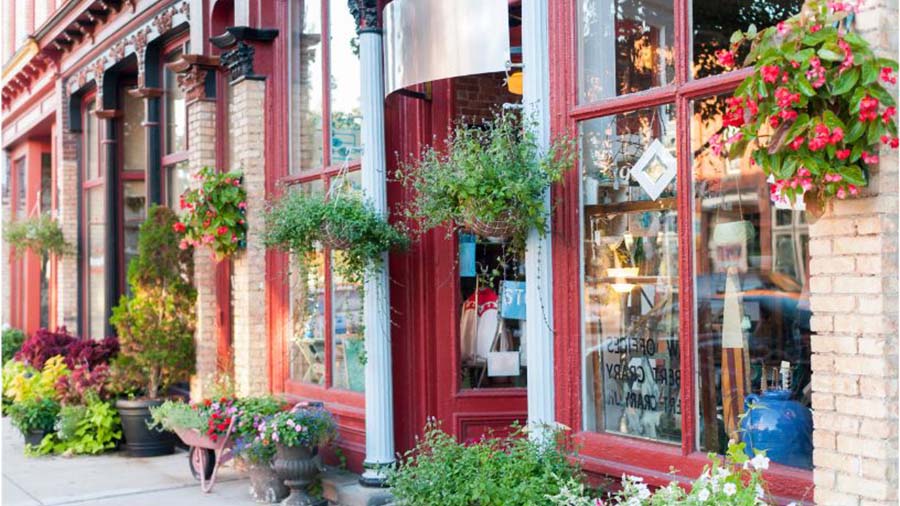Local businesses need to use multiple methods to reach potential customers. Gone are the days when simply hanging up your shingle did the trick. These days, consumers are more likely to do research and check out your business online, even if they are right around the corner. This is where local marketing starts to become important.
It’s hard enough to compete with big box retailers when your business is on Main Street. This is true for startups and established small businesses alike.
So, how do you market your business locally? And what does that even mean? Let’s answer that, and then I’ll share five local marketing strategies that can help your small business grow and thrive.
What is Local Marketing?
Local marketing is an umbrella term for your marketing mix that is focused on a specific area. It can be defined by zip code, metro area, or, most often by consumers who are in a specific radius. You can - and should - start with your business address and think about how far people might travel to visit your location.
For example, if your business is in the center of Augusta, Ga, and you think people will travel up to 25 miles for your goods or services, your local marketing area would look like this:
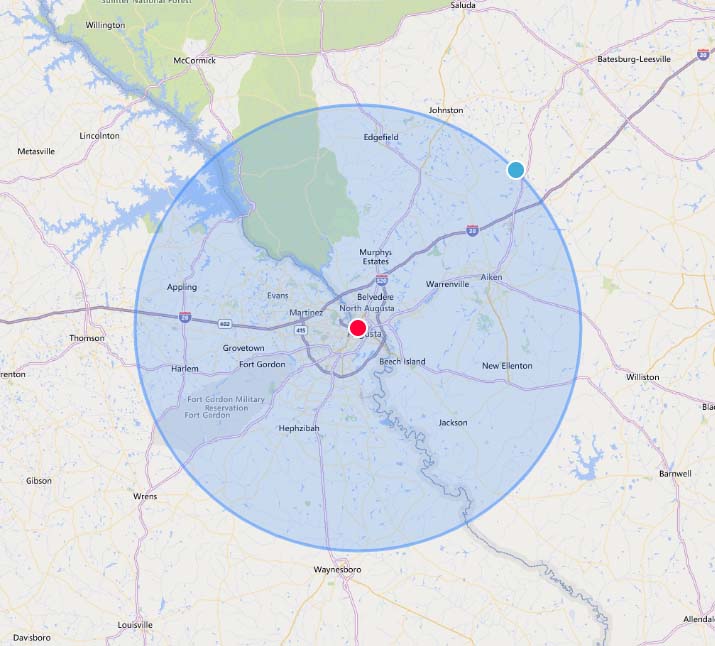
Credit: calcmaps.com
In this example, the area in the circle is your local marketing area.
By defining your local marketing area you can become more accurate in reaching your target audience and understanding your customers.
What if I Have More Than One Location?
If your business has multiple locations, you should identify the local market for each. Continuing with our example, let’s say you’re a chef who owns a restaurant in Augusta, and also one in Aiken, SC. Even though these locations are within 25 miles of each other, the radius for each is different.
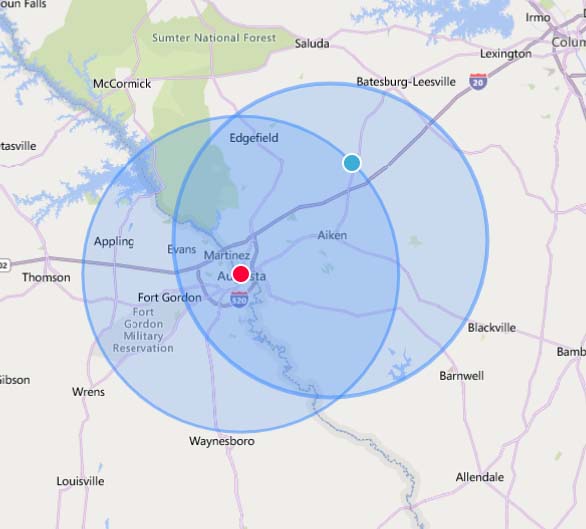
Credit: calcmaps.com
What is Organic Marketing?
Organic marketing refers to marketing strategies that do not require advertising spend. Generally speaking organic marketing takes longer than paid advertising. On the other hand, it can be more lasting and rewarding. Most small businesses incorporate a variety of paid and organic strategies into their marketing mix. While a startup might invest more heavily in paid ads to get some fast traction, no business should ignore organic marketing.
Plus, it’s free, aside from the sometimes significant effort you and your team puts in.
Local Organic Marketing Strategies
Once you’ve determined your local marketing area, think about how you can optimize your small business to reach potential customers. Here are five ways to do just that:
1. Make Sure Your Website is Aligned with Your Location
There are lots of ways you can optimize your web content for local search traffic, and most of them are pretty easy to implement. These simple steps will be a great start to your local marketing efforts.
Need help getting your website optimized for local? Let me know.
2. Get On Google My Business
The odds are pretty good that you’ve been looking for something recently and added “near me” to the end of your search. How often does that happen? According to Neil Patel’s Ubersuggest, the answer is, “a lot.” The search term “restaurants near me” happens almost 25 million times per month in the U.S. Some of them are happening in your local marketing area.

This is where Google My Business comes in. It is a tool that can help small businesses manage their web presence, and as the business owner, you can claim and edit it. Specifically, when you do that search for restaurants near you, what you see in the search results are Google My Business listings.
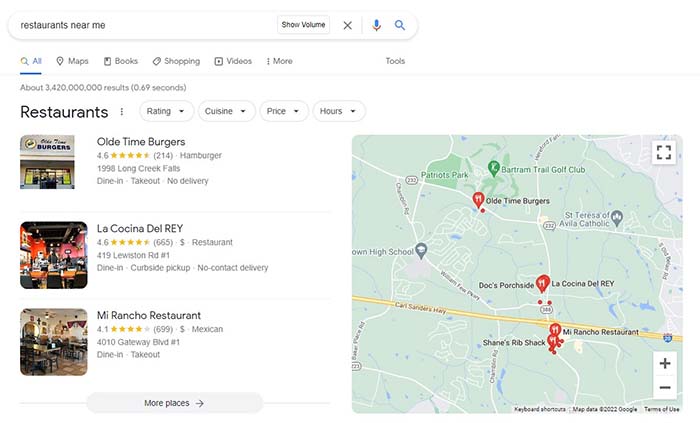
These results literally drive business to your door and your website. When you set up or claim your Google My Business listing, you also have the opportunity to manage how your small business appears on maps, modify your hours, and more. One caveat: in most (but not all) cases you must have a physical business location to be eligible for Google My Business. Think of it as a way to get a leg up on competitors large and small in your local marketing area.
3. Get Local on Social Media
You have a fair amount of control over your social media business pages, and you should make sure they clearly display your location.
Better still, your business’s social media pages are a great place to post local pictures, and if you aren’t taking them, you should be. With permission you can tag customers, many of whom have local friends, celebrate anniversaries, showcase products, and introduce local sales.
When your business is active on social media you are giving people within your radius a change to engage, comment, share, and review. These things are a great way to expand your reach and attract new followers.
Establish Social Proof

People want to read reviews before they buy products or services. And, they want to ask their friends about them and the experiences they’ve had. Social media platforms are a natural place for consumers to do this research. The reviews you have, the way people share your business and talk to one another all make up your social proof. The more you have, the more your business will grow. If you want an in-depth look at social proof, Sprout Social has a nice writeup here.
Build Social Proof by Asking for Reviews
A key to building your small business’s social proof is to ask for reviews. Social media platforms make it easy for customers to leave a review, and share it, but you shouldn’t stop there. You can ask customers in-store to leave a review, either online or by completing a simple form. You can and should do the same on your website. Just remember to keep it simple and fast for a customer. Don’t ask a lot of questions; just give them space to share their thoughts.
4. Get Involved in Your Community
For many small business owners there is little distinction between owner and business. This can be particularly true in local marketing, as people may be as likely to know your name as the name of your business.
This isn’t a bad thing. People appreciate and even prefer to do business locally. The more you get yourself and your business out in the community, the more visible and memorable your business will become. And regardless of the size of your city, there are always things going on to get involved in. Most local newspapers and even municipal websites keep a list of upcoming events. Find a couple that are interesting to you and that attract the demographic your business wants to reach and jump in.
It can be hard to find time to do things like this when you own a small business, but in the long-run it’s worth it. At the very least, check out your local Chamber of Commerce. It will have plenty of opportunities for you. After all, that’s why they exist. Beyond that there are plenty of non-profit organizations that would love your involvement. And, you’ll find sports teams of all ages that could use a hand.
5. Take Your Marketing Beyond the Web
It has become easy to think of all marketing as digital, but that doesn’t address all the ways you can market your small business. In fact, there are lots of “old fashioned” ways you can market your small business locally.
For example, if your business has foot traffic, put a chalkboard sign out front. These are attention-grabbing things that people naturally slow down to read as they pass by. Without one, a potential customer could walk by your business and not even realize it’s there. Chalkboard signs are also an easy way to highlight your products, including specials, sales, and discounts. Get creative!
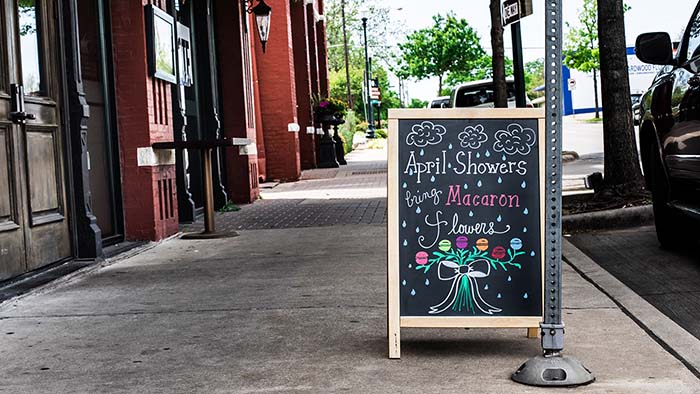
Another simple way to market your business is to get in touch with your hometown newspaper and radio stations. Most newspapers will be happy to publish a brief writeup of your business and what makes it unique. And, they will naturally focus on the local aspect.
Similar opportunities may exist on local radio stations. Lots of communities feature daily or weekly talk/news shows that focus on what’s happening around town. The hosts of these shows need people to talk to and it doesn’t hurt to reach out with a thoughtful email. Just keep in mind this isn’t a direct advertisement for your business. Be prepared to talk about the community and let your host handle introducing you and your company.
The Big Picture
Marketing your small business or startup doesn’t have to be hard or expensive. There are many things you can do to get exposure without spending anything more than time and effort. First, figure out where your prospective customers are, and then think about the best ways to reach them.
The tips above can help you get started. Put together a list of two or three things you want to try, and then write down the steps you need to take to meet each one. When you have that, put them in your calendar - you’re far more likely to do them that way.
If you are patient and persistent, your business can become a well-known name in your community. As a result, your audience, leads, and sales will grow.

